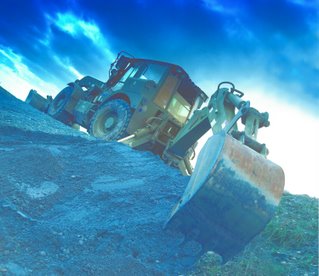Sunday, January 13, 2008
In praise of the armored combat earth mover

Posted by John Keller
Vetronics coverage in publications like ours usually involves the big, powerful, complicated stuff like the M-1 Abrams main battle tank and the M109 self-propelled howitzer. You can hardly blame us; not only do these vehicles have advanced electronics, but they make a lot of noise, fire, and smoke. What could be more compelling?
Sometimes we cover the less exciting vehicles and their electronic systems. Today's lead story, for example, concerns the new Medium Mine Protected Vehicle (MMPV), which is designed to withstand blasts from improvised explosive devices.
Rarely, however, does our vetronics coverage extend to armored vehicles like the combat earth mover, and for this omission we freely acknowledge our negligence. Usually only military branches like the Army Engineers and the Navy Seabees learn much about combat construction vehicles, but I recently stumbled over this story that I have to share.
It's about the High Mobility Engineer Excavator (HMEE) from JCB Inc. in Pooler, Ga., which is set for duty in Iraq and Afghanistan. I can see how we might overlook a combat vehicle like this, since its most sophisticated vetronics is limited essentially to its ABS braking technology and computer diagnostics. Its vetronics, however, is not the most notable aspect of the MMPV. I'll tell you what is ...
... this is a backhoe that can go 60 miles an hour, not only on paved roads but cross country as well. If you don't believe me, take a look at the accompanying video, which features a drag race between the HMEE and a civilian backhoe. The race isn't even close, and it's easy to see why JCB has won a $209 million U.S. Army contract to build 800 of these armored construction vehicles for front-line duty.
Any kidding aside, combat vehicles like this -- believe it or not -- in the near future could become important weapons against terrain-following cruise missiles, which are programmed to follow known land features as guides to their targets.
When we think about missile defense, what most quickly comes to mind? Laser defenses, electronic jammers, even air-to-air missiles. What happens, however, if those defenses either cannot be brought to bear, or would be ineffective?
Think outside the box. Need to spoof a terrain-following missile? How about changing the terrain? In those terms, what better weapon would we have than an HMEE that's able to lift more than 2.2 tons, dig a depth of almost 13 feet, and move as fast as 60 miles an hour in battlefield conditions?
Get rid of a little hill here, add another one there, and dig some curvey trenches that look like gullies and you could have a bunch of very confused cruise missiles.
Sometimes perhaps the low-tech approach might be best. It's worthwhile to think about that once in a while.

Posted by John Keller
Vetronics coverage in publications like ours usually involves the big, powerful, complicated stuff like the M-1 Abrams main battle tank and the M109 self-propelled howitzer. You can hardly blame us; not only do these vehicles have advanced electronics, but they make a lot of noise, fire, and smoke. What could be more compelling?
Sometimes we cover the less exciting vehicles and their electronic systems. Today's lead story, for example, concerns the new Medium Mine Protected Vehicle (MMPV), which is designed to withstand blasts from improvised explosive devices.
Rarely, however, does our vetronics coverage extend to armored vehicles like the combat earth mover, and for this omission we freely acknowledge our negligence. Usually only military branches like the Army Engineers and the Navy Seabees learn much about combat construction vehicles, but I recently stumbled over this story that I have to share.
It's about the High Mobility Engineer Excavator (HMEE) from JCB Inc. in Pooler, Ga., which is set for duty in Iraq and Afghanistan. I can see how we might overlook a combat vehicle like this, since its most sophisticated vetronics is limited essentially to its ABS braking technology and computer diagnostics. Its vetronics, however, is not the most notable aspect of the MMPV. I'll tell you what is ...
... this is a backhoe that can go 60 miles an hour, not only on paved roads but cross country as well. If you don't believe me, take a look at the accompanying video, which features a drag race between the HMEE and a civilian backhoe. The race isn't even close, and it's easy to see why JCB has won a $209 million U.S. Army contract to build 800 of these armored construction vehicles for front-line duty.
Any kidding aside, combat vehicles like this -- believe it or not -- in the near future could become important weapons against terrain-following cruise missiles, which are programmed to follow known land features as guides to their targets.
When we think about missile defense, what most quickly comes to mind? Laser defenses, electronic jammers, even air-to-air missiles. What happens, however, if those defenses either cannot be brought to bear, or would be ineffective?
Think outside the box. Need to spoof a terrain-following missile? How about changing the terrain? In those terms, what better weapon would we have than an HMEE that's able to lift more than 2.2 tons, dig a depth of almost 13 feet, and move as fast as 60 miles an hour in battlefield conditions?
Get rid of a little hill here, add another one there, and dig some curvey trenches that look like gullies and you could have a bunch of very confused cruise missiles.
Sometimes perhaps the low-tech approach might be best. It's worthwhile to think about that once in a while.
